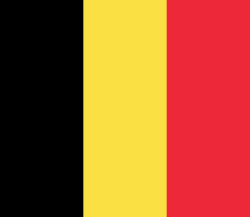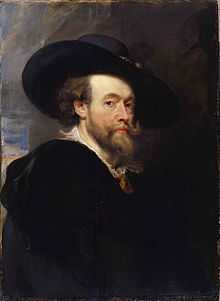Art of Belgium
| Part of a series on the |
| Culture of Belgium |
|---|
 |
| History |
| People |
| Languages |
| Cuisine |
| Festivals |
| Religion |
| Art |
| Literature |
|
Music and performing arts |
|
Media |
| Sport |
|
Monuments |
|
Symbols |
|
Despite its size, Belgium has a long and distinguished artistic tradition that goes back to the Middle Ages, considerably pre-dating the foundation of the country itself.
History of Belgian art
Medieval art
Mosan art is a regional style of Romanesque art from the valleys of the Meuse in present-day Wallonia, and the Rhineland, with manuscript illumination, metalwork, and enamel work from the 11th, 12th and 13th centuries. Among them the masterpiece of Renier de Huy and perhaps of the whole Mosan art Baptismal font at St Bartholomew's Church, Liège. The architecture of Roman churches of the Walloon country are also named Mosan, exemplified by the Collegiate Church of Saint Gertrude in Nivelles, and the churches of Waha and Hastière, Dinant. The Ornamental brassware is also a part of the Mosan art and among these dinandiers Hugo d'Oignies and Nicholas of Verdun.
Early Modern art

During the so-called Northern Renaissance, Belgium experienced an artistic boom, spawning the immensely popular Baroque Flemish school of painting. The cities of Bruges and Antwerp, some of the richest in the region, became artistic centres during the period.
The artist Peter Paul Rubens painted in Belgium between 1609-1621, working for many royal patrons from his studio in Antwerp. Rubens' house in Antwerp, the Rubenshuis, is now a museum.
Anthony van Dyck, celebrated for his painting of British court, including Charles I, was born in Antwerp.
Flemish art was not confined to the boundaries of modern Flanders and several leading artists came from or worked in areas in which langues d'oïl were spoken, from the region of modern Wallonia, e.g. Robert Campin, Rogier van der Weyden (Rogier de la Pasture) and Jacques Daret. Joachim Patinir Henri Blès are generally called mosan painters. Lambert Lombard (Liège, 1505 – 1566) was a Renaissance painter, architect and theorist for the Prince-Bishopric of Liège. Gérard de Lairesse, Bertholet Flemalle were also important painters in the Prince-Bishopric of Liège.
The Brueghel Dynasty

- See also Bruegel Family
Flemish genre painting is strongly tied to the traditions of Pieter Bruegel the Elder and was a style that continued directly into the 17th century through copies and new compositions made by his sons Pieter Brueghel the Younger and Jan Brueghel the Elder. Many of these are kermis paintings and scenes of peasants partaking other outdoor enjoyments viewed from an elevated viewpoint.
Belgian art in the 19th-20th centuries
Belgian Impressionism
Originating in France, the Impressionist style was also adopted by Belgian artists. Anna Boch, Eugène Boch (a close friend of Vincent van Gogh), Georges Lemmen and Théo van Rysselberghe were all influential Belgian impressionist or neo-impressionist painters.
During the 19th and 20th centuries many original romantic, expressionist and surrealist Wallon painters emerged, including Félicien Rops, Paul Delvaux, Pierre Paulus, Fernand Verhaegen, Antoine Wiertz, René Magritte, etc... The avant-garde CoBrA movement appeared in the 1950s.
Belgian Surrealism
Surrealism developed in Belgium during the inter-war period. The best known Belgian surrealist, René Magritte, exhibited in 1927 for the first time.
Sculpture

Jacques du Broeucq was a sculptor of the 16th century, known for his religious scenes and as the teacher of the famous Italian late-renaissance sculptor Giambologna, who was himself born in Flanders.
Constantin Meunier was an influential Belgian sculptor of the late 19th-early 20th century, known for his figures, which unusually, often depict industrial workers. Meunier's work was very popular around Europe, coinciding with the rise of the political Labour movement in the late 19th century.
George Grard (1901 — 1984) was a Walloon sculptor, known above all for his representations of the female, in the manner of Pierre Renoir and Aristide Maillol, modelled in clay or plaster, and cast in bronze. Working in Liège too, Jean Del Cour, the sculptor of the Virgin in Vinâve d'Isle, Léon Mignon the sculptor of Li Tore, and Louis Jéhotte known for his statue of the Frankish emperor Charlemagne.
Architecture

Belgian architects from Belgium had been at the forefront of the Neoclassical architecture movement between the mid 18th and 20th centuries. The style enjoyed great popularity in Belgium and several neoclassical masterpieces, including Gembloux Abbey and the Château de Seneffe survive.
In the last quarter of the 19th century, the Belgian architect and furniture designer Gustave Serrurier-Bovy[1] is credited (along with Belgian architects Paul Hankar, Victor Horta and Henry van de Velde) with creating the Art Nouveau style, coined as a style in Paris by Bing.[2]
The Art Nouveau style enjoyed considerable popularity in Belgium until after the First World War. Numerous houses around Belgium in the Art Nouveau style designed by Victor Horta survive (though not his masterpiece, the Maison du Peuple) which are classified as by UNESCO as a World Heritage Site.
Cartoons
Comic art (known as bande dessinée or the 9th Art) first became popular in Belgium in the 1920s, but achieved huge popularity internationally after the Second World War. It is considered an essential part of Belgian visual culture, as well as one of the country's main artistic influences internationally.[3] The best known series, The Adventures of Tintin by Hergé, first appeared in 1929, and have been translated into fifty languages, selling a total of 200 million copies.[4] Belgian artists were heavily involved in the pioneering of the Ligne Claire and other artistic styles in comic strips.
A museum in Brussels, the Belgian Comic Strip Center, is devoted to Belgian cartoon art.
Notable art collections in Belgium
The most significant art collection in the country is the national collection at the Royal Museums of Fine Arts of Belgium in Brussels, however, there are more than a dozen other significant art collections around the country.
Some of the most impressive are the Royal Museum for Fine Arts in Antwerp, which houses a considerable collection of works by Peter Paul Rubens, the Groeningemuseum in Bruges, with exhibits Flemish Primitives, the Musée des Beaux-Arts Tournai which contains important works of important 19th century French painters like Manet, Monet, Seurat and others, the Museum of Fine Arts, Ghent (MSK) which focuses on Flemish Art (Southern Netherlands) but also has several European - especially French - paintings and sculptures and the Museum Aan de Stroom (MAS), which is the biggest museum in Belgium.
There are also numerous smaller museums, often supported by the state, focused on individual artists, with museums devoted Magritte, Wiertz and Meunier amongst many others.
Belgium also has numerous galleries devoted to collections of non-indigenous art, including Oriental,[5] Classical[6] and Congolese[7] painting, sculpture and other visual art.
See also
References
- ↑ "Furniture by Gustave Serrurier-Bovy". Art Net. Retrieved 26 March 2013.
- ↑ "Art Nouveau in Belgium (1880-1914)". Your Antique Furniture Guide. Retrieved 26 March 2013.
- ↑ "Comic book capers". Expatica.com. 6 October 2008. Retrieved 26 March 2013.
- ↑ Kennedy, Maev (19 November 2003). "Museum aims to draw crowds with cartoon boy wonder aged 75". The Guardian (UK). Retrieved 12 September 2006.
- ↑ "Museums of the Far East, Laeken" (in French). Retrieved 10 November 2012.
- ↑ "Ancient collection of the Musée du Cinquantenaire" (in French). Retrieved 10 November 2012.
- ↑ Over 4,000 Congolese works of art in the Royal Museum for Central Africa alone, according to "Unique and priceless heritage An overview of our collections". africamuseum.be. Retrieved 10 November 2012.
Further reading
| Wikimedia Commons has media related to Art of Belgium. |
- "Art Museums in Belgium, artcylopedia.com". Retrieved 10 November 2012.
| ||||||||||||||